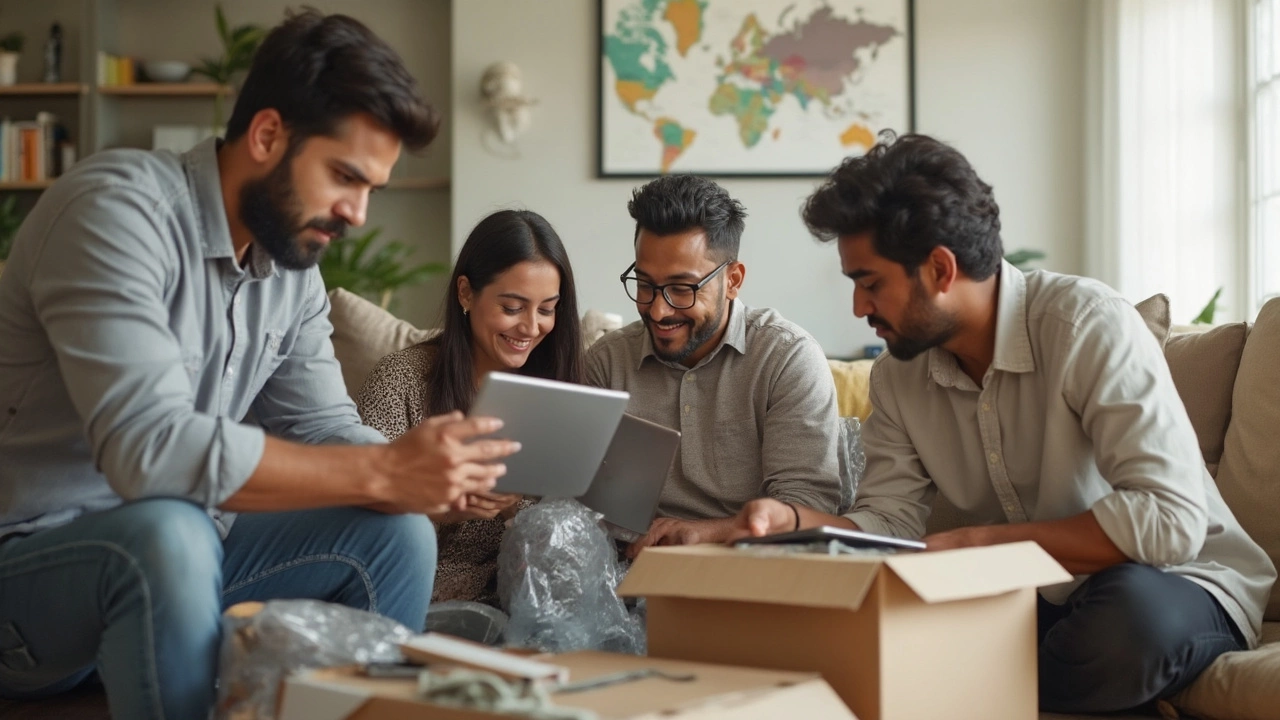If you’re thinking about sending electronics from India to the USA, you’re definitely not alone. With the rise in Indian electronics manufacturing, a lot of people—from small business owners to folks just mailing a laptop to family—are asking how to make this work.
Here’s the good news: Shipping electronics from India to the USA is doable. But, before you start packing your gadgets, you need to know about customs rules, paperwork, and some tricky details that can trip you up if you’re not prepared. Shipments aren’t just about tossing your device in a box and waving goodbye—you could face delays, extra costs, or outright confiscation if you miss a key step.
Post offices, courier services like DHL or FedEx, and freight forwarders can all ship your electronics. Each method has different costs and paperwork. The big thing is making sure your items are allowed and your documents (especially invoices and product details) match what’s inside the box. Customs officers check this stuff, and little mistakes can mean big headaches.
- Is Shipping Electronics Legal and Possible?
- What You Can Ship and What’s Not Allowed
- Paperwork, Customs, and Charges
- Tips to Make Shipping Trouble-Free
Is Shipping Electronics Legal and Possible?
Let’s clear this up right away: Yes, you can legally ship most electronics from India to the USA, as long as you follow some basic rules. The United States and India both have a solid framework for this, and thousands of parcels make the trip every single day. From mobile phones and laptops to circuit boards and headphones, it’s all possible, given you stick to allowed items and follow standard shipping law.
The US Customs and Border Protection (CBP) website says,
"Personal electronics for individual use are usually permitted for import, but they must be declared and may be subject to duty."
This means you need to check what counts as a personal shipment (like a single laptop) versus commercial (like a box full of smartwatches to resell).
Here’s what makes it legal and possible:
- You’re not sending banned or restricted electronics—think walkie-talkies with wrong frequencies or items with big lithium batteries that aren’t packed right.
- Your shipment has a proper invoice and value declaration.
- You aren’t breaking rules about dual-use tech (electronics that could be used for military or spying).
Want it in numbers? Take a look at how much India exported in electronics to the USA last year:
| Year | Electronics Exports from India to USA (USD Billion) |
|---|---|
| 2024 | 3.65 |
| 2023 | 2.8 |
Those shipments include everything from phones to computer parts. You’re joining a huge crowd doing the same thing.
When it comes to sending stuff for personal reasons—like mailing a laptop to your friend who just moved to the States—it’s even easier. The process is streamlined, but you still have to declare everything honestly. The most important rule in ship electronics India to USA is being upfront about what’s in your box and its value. Sneaky tricks aren’t worth it; customs can check, and if they find you in the wrong, you might lose your item and face fines.
Stick to the rules and make sure you’re not shipping prohibited or fake electronics, and you’ll have no problem getting your gadget across the border.
What You Can Ship and What’s Not Allowed
Now, let’s get straight to the point. You can send a bunch of electronics from India to the USA—mobiles, laptops, tablets, cameras, PC parts, smartwatches—you name it, as long as they aren’t banned or restricted. But the catch is there are a few rules you’ve got to follow. The USA is okay with most consumer electronics for personal use or resale, but there are some sticky areas you’ll want to avoid.
First, let’s talk about the things you can generally ship with no major headaches:
- Mobile phones (new or used, but not fake or uncertified models)
- Laptops and tablets (again, genuine products only)
- Headphones, earphones, speakers
- Digital cameras and camcorders
- Gaming consoles and accessories
- Computer parts like RAM, SSDs, processors, and graphics cards
For any of these, you’ll need a bill or invoice—always. Even if you’re sending an old phone to your cousin, write out a basic value; customs cares about declared value for taxes.
Here’s the stuff you CANNOT or should NOT ship:
- Counterfeit or clone electronics (like fake iPhones or knockoff brands)
- Items that violate US safety standards (such as uncertified chargers with dodgy wiring)
- Used lithium batteries not safely packed or labeled
- GPS devices with high-power transmitters (some require special clearance in the US)
- Devices with hidden cameras, jammers, or equipment banned for privacy/security reasons
Certain electronics, like drones, wireless transmitters, or equipment that connects to US cellular networks, might need extra paperwork—import permits or FCC clearance. If it connects over a mobile network, double-check that your hardware meets US specs. Otherwise, customs could reject it or ask for proofs.
| Item | Allowed? | Extra Paperwork? |
|---|---|---|
| Smartphone | Yes | Invoice |
| Laptop | Yes | Invoice |
| Drone | Sometimes | May need FAA clearance |
| Fake AirPods | No | Confiscated |
| Used lithium battery (loose) | No | Banned |
| Bluetooth speakers | Yes | Invoice |
Customs isn’t joking about “counterfeit.” Stats show that 87% of electronics seizures at US customs in 2023 were due to fake products. Don’t risk losing your package—make sure every item is original and includes clear labeling.
And here’s a handy tip: always check your carrier’s specific rules for packaging. For instance, DHL and FedEx require lithium batteries to be inside the device and correctly declared. Shipping rules are strict about batteries because of fire risk on planes.
If you stick to genuine stuff and do the paperwork right, the ship electronics India to USA route is wide open for you.

Paperwork, Customs, and Charges
If you’re shipping electronics from India to the USA, paperwork is the first hurdle. Customs on both sides want to know exactly what you’re sending and how much it’s worth. Here’s the thing—mess up your paperwork, and you risk losing your item or paying surprise penalties. The most crucial form is the commercial invoice. If you’re using a courier, they usually need an invoice that tells what the product is, how much it costs, and where it’s headed. If you’re just sending a used laptop to a friend, be clear it’s for personal use and not for resale.
You’ll also need to fill out a shipping declaration. This is either the CN23 (for post) or the courier’s own form. Here’s a quote from FedEx, which sums it up pretty well:
“For shipments to the U.S., customs authorities require an invoice with full item descriptions, quantities, and values, and may request documents proving purchase or ownership.”
For high-value shipments (over $2,500 USD), you might have to file an Electronic Export Information (EEI) through the Automated Export System (AES). It’s extra hassle, but it’s not optional. Also, expect the U.S. customs border (CBP) to check for things like lithium batteries, which have strict shipping rules because of fire risks.
Here’s what a typical process looks like:
- List the correct HS (Harmonized System) code for your device—this is a four-to-six digit number that tells customs exactly what the item is.
- Fill out the invoice and declaration forms fully, with brand, serial number, and value.
- If the device uses batteries, check if there’s a need for a special label.
- Attach all paperwork on the outside of your package, and keep digital copies just in case.
Shipping charges depend on both size and value. But the real sticker shock comes from customs duties and taxes. The U.S. currently charges zero duty for most consumer electronics like laptops and phones, but you may still have to pay a processing fee or state taxes if the item’s value is high or if you’re sending in bulk.
Here’s a basic look at possible costs:
| Item | Typical Customs Duty (USA) | Other Possible Charges |
|---|---|---|
| Smartphones | 0% | State tax, processing fee |
| Laptops | 0% | State tax, processing fee |
| Accessories | Up to 4% | State tax |
One big tip: If your ship electronics India to USA package gets stuck at customs, act fast. Contact your courier or the customs office for help. Sometimes, just sending extra paperwork or proof of purchase can fix things.
Tips to Make Shipping Trouble-Free
If you want to avoid trouble when you ship electronics India to USA, a little prep goes a long way. Let’s get into some practical moves that’ll help you sidestep the common mess-ups.
- Double-check the paperwork: Fill out your commercial invoice clearly. Make sure you write the exact product name and model, not just “gadget” or “gift.” Customs will match your form with what’s actually in the box. Even one wrong letter can slow things down.
- Use the right HS code: Indian and US customs expect you to mention the proper Harmonized System (HS) code for electronics. For example, smartphones and laptops each have separate numbers. It’s public info—just Google “HS code” with your product name.
- Don’t forget the battery rules: Shipping anything with lithium batteries? Couriers like DHL and FedEx need you to declare it. There are size limits, and you can’t hide batteries in the package hoping nobody notices—the scanners will catch them.
- Pick a reliable courier: The cheapest option isn’t always safest. Indian Post does work, but if you want tracking and faster delivery, use FedEx, UPS, or DHL. It costs a bit more, but you’ll avoid surprise delays.
- Insure if it matters: If you’re sending expensive stuff, always get insurance. Weird things can happen in transit, and lost parcels aren’t uncommon.
- Pack the right way: Use sturdy boxes. Wrap your electronics with bubble wrap. Add padding—shocks and drops are normal in shipping. Mark the box as “Fragile” for extra care.
- Check restriction lists: Some electronics (like certain radios, spy cams, or drone models) get flagged by US customs. If it’s unusual tech, check the latest US import restrictions before you ship it.
- Check the declared value: Be honest when you declare the item’s value. If customs finds your $500 phone listed as a $50 “toy,” they’ll hold it up. Customs fees depend on value, and under-declaring can backfire fast.
Most headaches happen because folks skip these steps or trust that nothing can go wrong. I once sent Maya’s old phone to my cousin in New Jersey. Forgot to mention the lithium battery—boom, held up in Mumbai for a week. One small detail can make or break the whole shipment, so stay alert.









